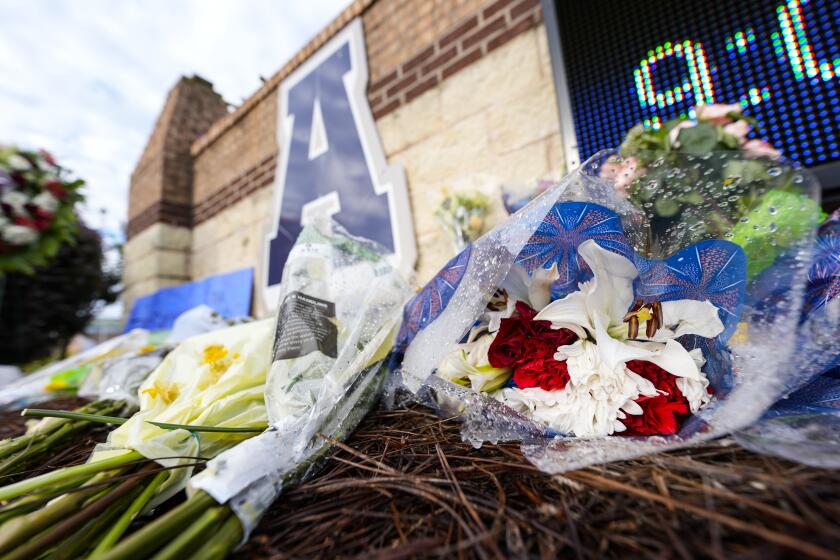Powerful Cyclone Phailin forces massive evacuations in India
NEW DELHI -- India was battered by a massive cyclone Saturday as nearly half a million people evacuated to shelters in vulnerable coastal and low-lying areas amid power outages, large storm surges and canceled trains and flights.
Officials said Cyclone Phailin was expected to affect 12 million people in the eastern states of Odisha and Andhra Pradesh with the potential to become a âsuper cyclone,â which occurs when wind speeds exceed 135 miles per hour.
âThis is one of the largest evacuations undertaken in India,â Shashidhar Reddy, vice chairman of the National Disaster Management Authority, told reporters in the capital, New Delhi. âOur priority is to minimize loss of life.â
PHOTOS: India battered by massive cyclone
In a statement, the India Meteorological Department said the storm was packing winds of up to 130 miles per hour and was expected to cause an 11-foot surge in ocean levels. The worst of the damage was expected to occur Saturday evening as Phailin moved northwest at around 12 miles per hour from the Bay of Bengal. âIndia braces for Phailin Fury,â said one TV headline. âIndiaâs Katrina,â flashed another.
The U.S. Navyâs Joint Typhoon Warning Center in Hawaii forecast higher speeds, at one point projecting maximum sustained winds of 167 miles per hour with gusts up to 196 miles per hour.
Television footage showed large waves battering the shore, wind-wrecked palm trees and communities blacked out by power cuts as hundreds of people lined the shore looking out to sea in the direction of the storm.
In many communities, Muslims and Hindus crowded mosques and temples to pray that Phailin would not match the damage of a storm in 1999 in Odisha, then known as Orissa, that killed some 10,000 people over a 30-hour period after winds reached 210 miles per hour.
Phailin was expected to head inland and dissipate within about 12 hours, however, unlike its counterpart 14 years ago that hugged the coast, allowing it to gather continued strength from the sea and cause widespread damage.
Hundreds of people lined up at gas stations, grocery stores and automated teller machines in Bhubaneshwar, the state capital of Odisha, as the storm approached trying to secure emergency supplies. âThe state has been in panic mode,â Sahashranshu Mohapatra, a local television researcher, said by telephone.
The Indian government has not always had a great track record with crisis management, but officials said they were well prepared this time, with cargo planes, helicopters and naval vessels positioned in the eastern part of the country and hundreds of thousands of food packets assembled for possible use at relief camps.
âSome people were refusing to leave their homes,â said Pradip Kumar Mahapatra, Bhubaneshwarâs special relief commissioner. âBecause Odisha is prone to cyclones, they were under the impression that it wonât be severe. But now all [approximately 500,000] people have been evacuated from low-lying areas.â
âWe are hoping and praying for the best,â he added. âWeâre on top of the situation, as much as you can be in such situations.â
Given the poverty in many parts of India, the weather department warned of the particular danger to mud homes as well as the flooding of railroad tracks, power lines and cellphone communication equipment.
Messages posted on Twitter reflected the fears and concerns of many Indians. â#CyclonePhailin is like a powerful uninvited guest coming to ruin a family.. Prayers !!â said user @rupakpal.
Meteorologists said the storm surge -- a huge wall of water as a cyclone slams into the shore, expected to reach 20 feet or more with Phailin -- can be a bigger killer than the wind in storms of this type.
Some weather forecasters compared the cycloneâs size and intensity to Hurricane Katrina, which battered the U.S. Gulf Coast and caused catastrophic flooding in New Orleans in 2005, killing some 1,800 people and resulting in an estimated $75 billion in property damage.
Greenpeace India said it shares the concern of the victims of the cyclone, but added that average global temperatures would continue to rise, causing more intense tropical storms in some regions unless greenhouse gas and global warming were addressed. âThe climate change ball is rolling and people will suffer the consequences,â said Biswajit Mohanty, a Greenpeace India Board member, in a statement.
ALSO:
Nobel Peace Prize recipient is a relatively obscure watchdog
One week later, âDeath to U.S.A.â chant back in vogue in Iran capital
Ex-Formula One test driver Maria de Villota, 33, found dead in hotel
Tanvi Sharma in the New Delhi bureau contributed to this report.
More to Read
Sign up for Essential California
The most important California stories and recommendations in your inbox every morning.
You may occasionally receive promotional content from the Los Angeles Times.










